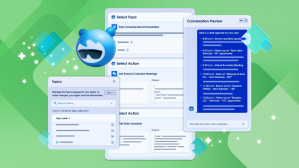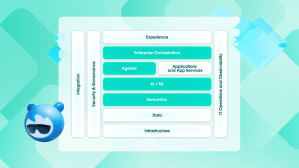Key Takeaways
- AI-powered voice assistants are transforming call centers by providing natural, immediate, and cost-effective customer support.
- Agentforce Voice uses real-time data to personalize interactions, understand customer intent, and appropriately escalate calls to human reps.
- Innovative technologies like low-latency reasoning engines and asynchronous logging are essential for making AI conversations feel fluid and reliable.
Tammy Taylor, a Director at the travel management platform Engine, has a simple yet ambitious goal: When her more than 1 million customers call, they should never have to press 0, suffer through hold music, or navigate endless automated menus.
That’s a tall order. Like most contact centers using traditional interactive voice response (IVR) systems to handle basic phone inquiries, the sheer volume of calls strains Engine’s 100 front-line agents.
Engine is piloting Agentforce Voice, which uses AI to listen, interpret, and respond to customers with natural language processing and machine learning. The Salesforce-built system immediately connects a caller to a remarkably human-sounding AI agent. And this digital assistant doesn’t just process words; it understands the customer’s language and quickly resolves common problems like reservation modifications and cancellations. Conversations are fast, contextual, and interruptible, allowing customers to clarify or change direction without starting over.
“We want to meet customers where they are and provide the best travel experience possible,” said Taylor. “The customer calls, talks to the system, and it solves your problem or hands you off to a human who can.”
Into a voice-driven future
There’s more at stake than convenience. Agentforce Voice can help enterprises achieve better economics. In customer service, for example, each call is estimated to cost $5 or more per resolution. That can turn what should be a relationship-building moment into a money swamp, especially for large enterprises that may field thousands of calls daily.
Most customer service centers are just a toxic cocktail of high costs and poor consumer experience.
Max Comparetto, Agentforce Product Manager, Salesforce
“Most customer service centers are just a toxic cocktail of high costs and poor consumer experience,” said Agentforce Product Manager Max Comparetto. “Traditional IVR flows and decision trees are often rigid and tough to set up. It’s not only an expensive channel to maintain, they’re often overloaded.”
At a time where our hands seem always occupied — gripping steering wheels, making dinner, holding kids, walking dogs — the ability to summon intelligent help through spoken words could reshape the sprawling telephone call center market, now estimated to be more than $135 billion annually. It also portends a future where voice is the primary tech interface.
Tackling challenges
For Salesforce, creating Agentforce Voice over the past year meant moving conversational AI capabilities beyond what simple chatbots could do. It required engineering to build voice agents that could learn, act on their own, and seamlessly integrate with existing business systems. The work also demanded innovations in natural language processing and real-time data sourcing and decision-making.
Personalizing the experience for callers was a critical objective. Agentforce Voice has to quickly access specific customer data during live calls to let the AI agent know a customer’s history, anticipate their needs, and avoid asking repetitive questions. To help provide that context, Agentforce Voice snaps into Salesforce’s broader platform, including Data Cloud, to integrate with CRM data, analytics, and other tools. It can also interconnect with existing telephony systems and datasets, enabling it to access and update records in real time.
“Customers want unified, voice-native experiences,” said Nancy Xu, VP of Product Management for AI Cloud at Salesforce. “With Voice, we’re giving them accurate, up-to-date answers that resolve their issues faster.”
At the heart of any voice-driven system, of course, is not only the ability to quickly and accurately differentiate words and phrases but also an understanding of customer intent, which is often revealed by not just what is said but how it’s conveyed. That’s a shortcoming for many IVR systems, which can lead to more calls being escalated to humans.
We don’t want the user to feel like they’re just talking to a robot.
John Emmons, Director of Research, Salesforce
“We don’t want the user to feel like they’re just talking to a robot,” explained John Emmons, a Director of Research at Salesforce. “We want a system that recognizes not just what the caller says but the meaning behind how they say it.”
The AI can also detect frustration from the words a caller is using and offer support, even escalating it to a human service representative if or when necessary. Critically, organizations can also customize tone and personality, as well as how the agent should behave in specific situations — such as when it doesn’t know an answer, how many times to ask for clarification, or when to escalate to a human.
Key tech innovations
Driving that conversational ease and depth of understanding are two key tech innovations that power Agentforce Voice’s rapid decision-making and reliability.
One is the Flash Planner, which serves as the system’s low-latency reasoning engine. It uses in-memory processing, precomputed execution plans, and optimized data structures to eliminate bottlenecks and achieve ultra-low-latency, conversational experiences. Instead of constantly searching through files stored on hard drives, the Flash Planner keeps essential information readily available in the agent’s working memory.
“This is critical because when you say something, you expect an answer as quickly as possible,” said Bob Van Osten, VP of Product at Salesforce. “It’s one of the keys to making the interaction feel more like a conversation with a human.”
Complementing the Flash Planner is the trust layer for asynchronous logging, a deft data juggler that separates recordkeeping from core operations. It’s essentially a reliability framework that ensures uninterrupted operation while maintaining accurate records of system activity. When the system needs to save important information, it doesn’t pause. Instead, it delegates logging to a background process while primary operations continue at full speed. Built-in safety measures ensure nothing gets lost or corrupted.
A broader future for voice
While companies like Engine and NeuraFlash — now a unit of the management consultancy Accenture — prepare to deploy Agentforce Voice on their customer service desks, the implications of the technology go much further.
Already, Comparetto says, Salesforce is exploring ways to use voice AI beyond calls coming into a contact center. For example, the team is working on outbound scenarios that leverage the technology for sales calls and even broader sets of functions.
These AI voice applications could eventually transform all facets of business operations and everyday life. In a world increasingly dominated by text and screens, the human voice — enhanced by AI — may be the most natural interface of all.
Go deeper:
- Learn more about AI voice agents and read three reasons why AI voice agents are harder than they seem
- See Agentforce Voice in action live or on Salesforce+ at Dreamforce 2025
















